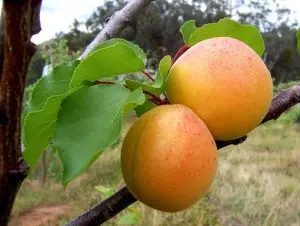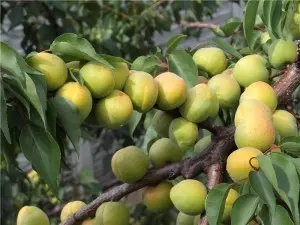In modern horticulture, a very large number of varieties of apricots have been bred, diverse both in appearance and taste of the fruit, and in the nature of the growth and development of the tree itself. But not everyone is very popular. Apricot pineapple is just such a variety. He earned the love of gardeners thanks to his fruits with high taste characteristics and abundant yields.
Variety description
Apricot pineapple, bred by the State Botanical Garden in the Crimea, belongs to medium-sized trees, with a wide, flat-rounded crown, prone to thickening. It has a satisfactory ability to shoot formation. It begins fruiting from 3-4 years after planting. It mainly bears fruit on annual shoots, overgrown twigs and fruit twigs. Therefore, for regular fruiting, it is necessary to annually carry out light, rejuvenating pruning of the tree in the spring and pinching the young growth in the spring.
This apricot belongs to the self-fertile varieties. Even if the tree is planted in a single variant on the site, the yield will be high. However, the presence of other varieties nearby, not only apricot, but also plums, peaches, cherry plums, will significantly improve the taste of fruits.
The average ripening period is the second half of July. After ripening, the fruits fall off strongly. A more detailed description of this variety can be found in the specialized literature.
The fruits are medium and large, weighing 35-45 g. They have an irregularly rounded, oblong shape. The skin is not very dense, medium pubescent. The surface is slightly bumpy, rough. Ripe apricots are dull, light yellow or golden in color, almost without blush. The pulp has a light yellow pineapple color with an orange tint and a pleasant aroma. Very juicy, medium density, soft fiber, sweet with a special aftertaste. The stone is small, the seed is sweet.

Advantages
One important advantage of pineapple apricot is increased resistance to such widespread diseases as leaf curl and clasterosporium. Differs in satisfactory winter hardiness and good drought resistance. Easily and quickly restored after freezing. And the later flowering period, in comparison with other varieties, allows you to survive spring frosts without risk to flower buds and ripen the fruits relatively quickly in a short time.
In addition, this variety is characterized by regular fruiting and a very high yield – with proper care from an adult tree, you can get up to 130-150 kg of apricot. The fruits are very large, flattened. They have high commercial, taste qualities and are well transportable. However, their keeping quality is relatively low – 8-16 days.

The benefits of apricot
Apricots contain a large amount of sugars, pectins, vitamins, organic acids, dextrin, inulin and others. The fruits are especially rich in vitamin C, P, B1, provitamin A, a lot of iron and calcium salts. It is thanks to this composition that it is very useful to use freshly squeezed apricot juice for young children, pregnant women and people in the postoperative period. Only 120-150 g of juice satisfy the daily requirement for carotene.
In addition, the fruits have a similar effect on hematopoiesis as the liver. Not only fresh apricots, but also dried apricots have a general strengthening effect on the body. The high concentration of potassium salts, sugars, magnesium, phosphorus, fiber makes this product indispensable for a healthy and active life. Apricots have a beneficial effect on the functioning of the gastrointestinal tract, help normalize blood pressure and neuromuscular excitability.

Video “How to plant an apricot”
This video covers in detail how to properly plant an apricot tree seedling. The nuances, possible difficulties and common mistakes are considered.









